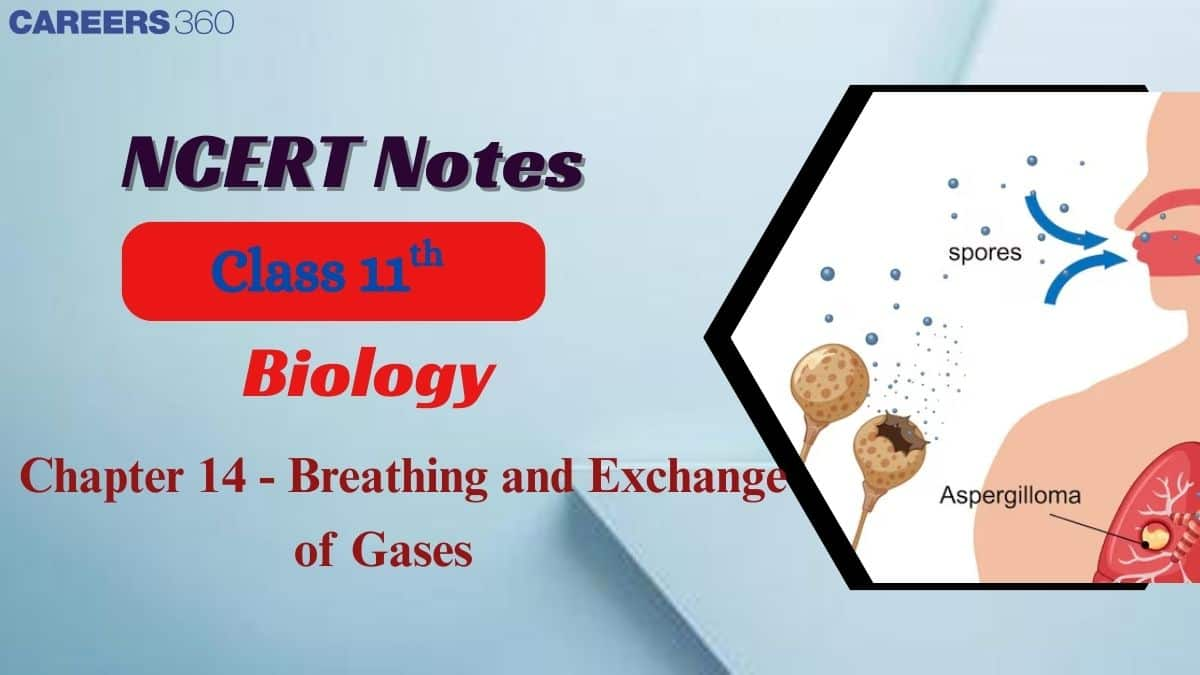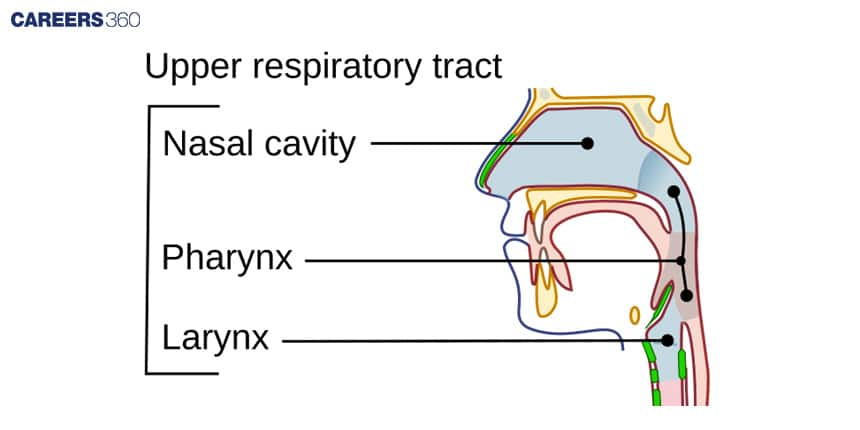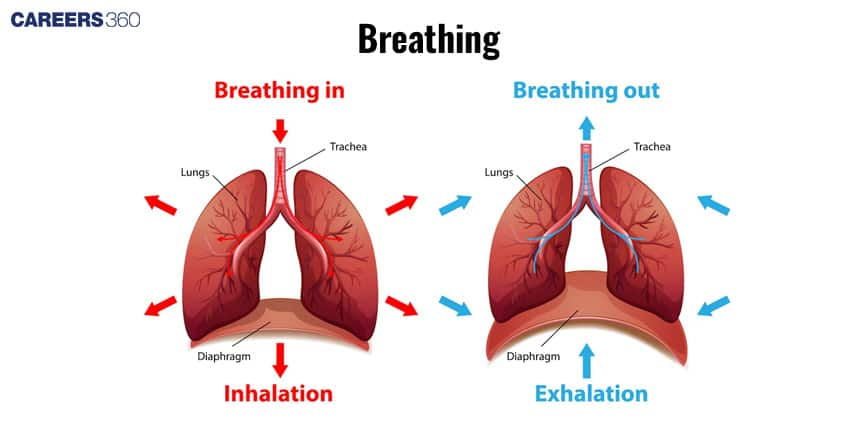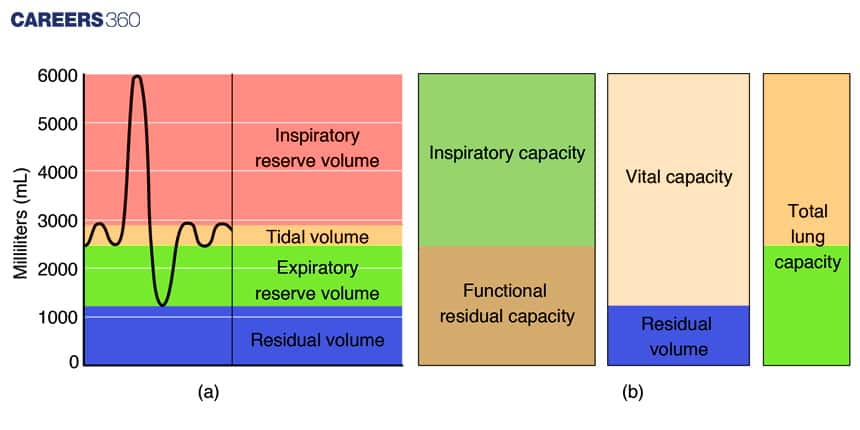NCERT Class 11 Biology Chapter 17 Notes Breathing And Exchange Of Gases - Download PDF Notes
Did you know that breathing is a continuous process that happens automatically, even when you're asleep? The NCERT Class 11 Biology Chapter 14 Notes Breathing and Exchange of Gases are written in simple and easy language, and include well-labelled diagrams. Breathing and exchange of gases include topics like how we breathe, the role of lungs, respiratory volumes and capacities, and disorders. These NCERT notes are very useful for quick revision before school exams and for competitive exams like NEET.
This Story also Contains
- NCERT Class 11 Biology Chapter 14 Notes: Download PDF
- Class 11 Biology Chapter 14 Breathing and Exchange of Gases Notes
- Chapter 14 Biology: Previous Year Questions and Answers
- How to Use Breathing and Exchange of Gases Class 11 Notes Effectively?
- Advantages of Class 11 Biology Chapter 14 Breathing and Exchange of Gases Notes
- Chapter-Wise NCERT Class 11 Notes Biology

The Breathing and Exchange of Gases Class 11 Notes help students build a strong foundation for higher classes. Knowing respiration is important to understand how oxygen supports cellular processes and metabolic activities. The NCERT Class 11 Biology Chapter 14 Notes PDF also discusses the role of hemoglobin in the transport of oxygen. The NCERT Notes for Class 11 are great for doing regular practice, helping students revise important topics, which boosts their confidence during exams.
NCERT Class 11 Biology Chapter 14 Notes: Download PDF
Breathing and Exchange of Gases is an important chapter that explains topics like respiratory volumes and the mechanism of breathing. The NCERT Class 11 Biology Chapter 14 Notes PDF provides a clear understanding along with labelled diagrams, and students can use it offline for quick revisions and last-minute preparation. The NCERT Notes for Class 11 Biology are perfect for performing well in exams in less time.
Also Read,
Class 11 Biology Chapter 14 Breathing and Exchange of Gases Notes
The Breathing and Exchange of Gases chapter covers key topics like the human respiratory system, the mechanism of respiration, transport of respiratory gases, and lung capacities. Class 11 Biology chapter 14 notes are prepared by subject experts, following the NCERT guidelines, making it a valuable resource for quick revision during the exam.
Human Respiratory System
The human respiratory system is tasked with the intake of oxygen and the expulsion of carbon dioxide. It is made up of a number of organs that collaborate to make breathing possible.
Organs Used in the Respiratory System
Nose: The main air entry point, covered with hair and mucus to trap dust and microbes.
Pharynx: Shared pathway for food and air that leads air to the larynx.
Larynx (Voice Box): The larynx holds the vocal cords and keeps food out of the trachea.

Trachea (Windpipe): A Cartilaginous ring-supported tube that provides free passage of air to the lungs.
Bronchi and Bronchioles: Two bronchi split off from the trachea, each traveling to a different lung, and then branch off into smaller bronchioles.
Lungs: Primary location of gas exchange, containing alveoli where oxygen is absorbed into the blood and carbon dioxide is expelled.
Function of Alveoli in Gas Exchange
The alveoli are small air sacs within the lungs that maximize the area for gas exchange. Oxygen in the incoming air diffuses into the bloodstream, and carbon dioxide in the blood diffuses into the alveoli to be expelled from the lungs. This is due to the gradient of gases.
Role of the Diaphragm and Intercostal Muscles in Breathing
Diaphragm: A dome-shaped muscle that flattens and contracts when inhaling, expanding lung volume.
Intercostal Muscles: They are between the ribs and expand the chest cavity during inhalation and contract during exhalation. These movements cause pressure differences to let air enter and leave the lungs.
Mechanism of Breathing
The Mechanism of Breathing takes place in two stages: inspiration (inhalation) and expiration (exhalation).
Process of Inhalation and Exhalation
Inhalation: The diaphragm contracts, the intercostal muscles inflate the ribcage, and lung volume increases. This results in a negative pressure within the lungs, which makes air rush in.
Exhalation: The diaphragm becomes relaxed, the intercostal muscles contract, and lung volume reduces, which results in a positive pressure forcing air out.

Role of Pressure Gradients in Lung Expansion and Contraction
Air movement is regulated by Boyle's Law, wherein pressure and volume are inversely proportional. When lung volume is greater, pressure within the lungs is lower, and air moves in. When lung volume is less, pressure is higher, and air is expelled.
Influencing Factors in the Breathing Rate
Concentration of Oxygen and Carbon Dioxide: Elevated levels of CO2 stimulate an increased rate of breathing.
Physical Exercise: Elevates the need for oxygen, resulting in more rapid and deeper breathing.
Altitude: Decreased oxygen at high altitudes elevates the breathing rate.
Emotions and Stress: Stress and anxiety will change breathing patterns.
Exchange of Gases
Gas exchange takes place as a result of partial pressure gradients. Oxygen moves from alveolar air into the bloodstream, and carbon dioxide moves from blood to alveoli. In the tissues, diffusion of oxygen occurs into the cells, and carbon dioxide into the bloodstream.
Transport of Oxygen by Hemoglobin
98% of oxygen is transported by hemoglobin in red blood cells.
Hemoglobin combines with oxygen to produce oxyhemoglobin in the lungs and releases it at low-oxygen tissue sites.
The oxygen dissociation curve depends on factors such as temperature, CO2 concentration, and pH.
Transportation of Carbon Dioxide in Blood
Carbon dioxide is transported in three ways:
Bicarbonate Ions (HCO3⁻): (~70%) CO2 combines with water to produce carbonic acid, which disintegrates into bicarbonate.
Carbaminohemoglobin: (~20%) CO2 combines with hemoglobin.
Dissolved in Plasma: (~10%) CO2 is dissolved directly in the blood plasma.
Respiratory Volumes and Capacities
Key Respiratory Volumes:
Tidal Volume (TV): Air that passes in a normal breath (~500 mL).
Inspiratory Reserve Volume (IRV): Additional air inhaled over normal inspiration (~2500–3000 mL).
Expiratory Reserve Volume (ERV): Additional air exhaled over normal expiration (~1000–1100 mL).
Residual Volume (RV): Air left in lungs following forced exhalation (~1100–1200 mL).
Lung Capacities:
Vital Capacity (VC): Total air exhaled following deep inhalation (TV + IRV + ERV).
Total Lung Capacity (TLC): Total capacity of air the lungs can hold (VC + RV).

Spirometry and Its Significance:
Spirometry is a diagnostic test for measuring lung volumes and capacities. Spirometry is utilized for diagnosing respiratory diseases such as asthma and COPD (Chronic Obstructive Pulmonary Disease).
Regulation of Respiration
The regulation of respiration is done by the medulla oblongata and pons in the brainstem.
Medulla Oblongata: Regulates breathing rhythm and depth.
Pons: Refines the process of breathing.
Chemical Control through CO2 and O2 Concentration in Blood:
Increased CO2: Activates respiratory centers to raise breathing rate.
Decreased O2: Can also cause increased breathing, but less than CO2.
pH alterations: Acidosis (low pH) quickens the rate of breathing, whereas alkalosis (high pH) reduces it.
Disorders Related to the Respiratory System
Common Respiratory Disorders:
Asthma: A chronic inflammatory disorder that brings about constriction of airways, making breathing cumbersome. Caused by allergens, cold temperature, or smog.
Emphysema: It is a respiratory system disorder in which alveoli are destroyed, decreasing the surface area for gas exchange. Usually due to smoking.
Bronchitis: Bronchial inflammation that results in excess mucus production and cough.
Pneumonia: A Bacterial or viral infection that results in inflammation of the lungs and filling of alveoli with fluid.
Effect of Smoking and Pollution on Lung Function:
Smoking: Raises the risk of lung cancer, emphysema, and chronic bronchitis by causing damage to lung tissues and decreasing oxygen transport efficiency.
Air Pollution: Exposure to air pollutants such as carbon monoxide, sulfur dioxide, and particulate matter results in respiratory distress, enhanced asthma attacks, and decreased lung function over time, which leads to lung diseases.
Also, Read
Chapter 14 Biology: Previous Year Questions and Answers
Going through the previous year's questions provided below allows students to test their knowledge. Students can solve these questions after studying the NCERT Class 11 Biology Chapter 14 Notes Breathing and Exchange of Gases.
Question 1: The respiratory process is regulated by certain specialised centres in the brain. One of the following listed centres can reduce the inspiratory duration upon stimulation.
Option 1. Medullary inspiratory centre
Option 2. Pneumotaxic centre
Option 3. Apneustic centre
Option 4. Chemosensitive centre
Answer:
Inspiration is the process of breathing in oxygen-rich air. The lungs' volume increases during inspiration as a result of the diaphragm being flat and the ribs being drawn higher and outward. To control inspiratory volume and respiratory rate, the pneumotaxic centre, which is situated in the upper pons, sends inhibitory impulses to the inspiratory centre, stopping inspiration. The fine-tuning of respiration most certainly involves this region.
Hence, the correct answer is option (2), Pneumotaxic centre.
Question 2: The oxygen-haemoglobin dissociation curve will show a right shift in the case of
Option 1. High pCO2
Option 2. High pO2
Option 3. Low pCO2
Option 4. Less H+ concentration
Answer:
The curve of oxygen and haemoglobin is shifted to the right when the pO2 decreases, pCO2 increases, the concentration of H+ increases, pH decreases, and body temperature increases. This rightward shift of the oxygen-hemoglobin dissociation curve is known as the Bohr effect, facilitating oxygen release to tissues during high metabolic activity. Such changes are crucial for meeting the oxygen needs of active tissues like muscles during exercise.
Hence, the correct answer is option (1), High pCO2
Question 3: In breathing movements, air volume can be estimated by
Option 1. Stethoscope
Option 2. Hygrometer
Option 3. Sphygmomanometer
Option 4. Spirometer
Answer:
A spirometer is used to estimate the breathing volumes. A spirometer is a medical device that measures the volume of air exchanged during breathing. It helps estimate various lung capacities and is essential for assessing respiratory health and function.
Hence, the correct answer is option (4) Spirometer
Also Read:
How to Use Breathing and Exchange of Gases Class 11 Notes Effectively?
Breathing is the process through which living organisms take in oxygen and release carbon dioxide. This process is important for cellular respiration and energy production.
Study the structure and function of human respiratory organs like lungs, alveoli, and the diaphragm to understand the mechanics of breathing.
Use Class 11 Biology Chapter 14 Breathing and Exchange of Gases Notes PDF to revise how oxygen and carbon dioxide are transported in the blood.
Draw and label diagrams of alveoli, trachea, and other structures to visualize the process clearly.
Refer to Class 11 Biology Chapter 14 Breathing and Exchange of Gases Notes to know about the environmental factors such as altitude, temperature, and humidity.
Practice previous year questions on breathing rate, oxygen transport, and carbon dioxide removal to strengthen understanding.
Advantages of Class 11 Biology Chapter 14 Breathing and Exchange of Gases Notes
Breathing and Exchange of Gases is an important chapter that explains how oxygen and carbon dioxide are exchanged and transported in the human body. Having well-organised and structured notes helps students understand complex processes easily.
- Class 11 Biology Chapter 14 Breathing and Exchange of Gases Notes PDF makes it easier for students to understand the mechanism of breathing and gas exchange.
- Important terms like tidal volume, residual volume, and vital capacity are explained clearly in the notes.
- By studying through the notes, students can improve their visual memory and retain concepts for a longer period.
- Differences between breathing in humans and other organisms are well-explained in the notes for comparative understanding.
- Regular revision of these notes saves time and improves conceptual clarity, by which students can perform well in the NEET exam.
Chapter-Wise NCERT Class 11 Notes Biology
The table below includes notes for all chapters of Class 11 Biology, helping students revise efficiently and prepare well for school as well as competitive exams like NEET.
Frequently Asked Questions (FAQs)
Inhalation and exhalation constitute breathing, which is powered by the diaphragm and intercostal muscles. The diaphragm contracts to increase lung volume during inhalation. It relaxes during exhalation, resulting in decreasing lung volume and pushing air out because of pressure differences.
Gas exchange takes place in the alveoli via diffusion, as explained in the NCERT Class 11 Biology Chapter 14 Notes Breathing and Exchange of Gases. Oxygen from alveolar air diffuses into the bloodstream, and carbon dioxide from the bloodstream diffuses into the alveoli. The process is facilitated by the gradient of partial pressures of gases.
Inhalation is the active intake of air, involving contraction of the diaphragm and expansion of the lungs. Exhalation is passive, with relaxation of the diaphragm, reduction in lung volume, and expulsion of air due to elevated pressure. For a more detailed difference, students can use the NCERT Class 11 Biology Chapter 14 Notes Breathing and Exchange of Gases.
Tidal volume (TV) refers to the air moved during a regular breath (~500 mL). Vital capacity (VC) refers to the maximum amount of air exhaled following maximum inhalation, comprising tidal volume, inspiratory reserve volume, and expiratory reserve volume.
Oxygen is mainly carried by hemoglobin in red blood cells as oxyhemoglobin. A fraction of it dissolves in plasma. It is offloaded at tissues with low oxygen partial pressure, where it is used for cellular respiration.
Hemoglobin picks up oxygen in the lungs and offloads it at tissues. It is also responsible for carrying carbon dioxide as carbaminohemoglobin and buffering blood pH, allowing for effective gas exchange.
Carbon dioxide is carried in three states: bicarbonate ions (70%), attached to hemoglobin as carbaminohemoglobin (20%), and dissolved in plasma (10%). The conversion of CO₂ to bicarbonate assists in keeping blood pH in balance.
Respiratory disorders that are common include asthma (inflammation of the airways), bronchitis (infection of the bronchial tubes), emphysema (damage to the alveoli), and pneumonia (infection of the lungs). Smoking and pollution exacerbate these conditions, causing breathing problems.
Courses After 12th
Applications for Admissions are open.
As per latest syllabus. Physics formulas, equations, & laws of class 11 & 12th chapters
JEE Main Important Chemistry formulas
Get nowAs per latest syllabus. Chemistry formulas, equations, & laws of class 11 & 12th chapters
JEE Main high scoring chapters and topics
Get nowAs per latest 2024 syllabus. Study 40% syllabus and score upto 100% marks in JEE
JEE Main Important Mathematics Formulas
Get nowAs per latest syllabus. Maths formulas, equations, & theorems of class 11 & 12th chapters
